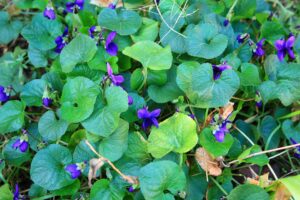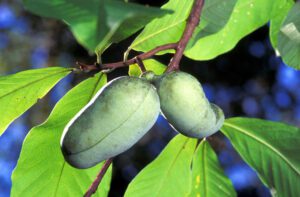Important Note: As with any foraging, please proceed with caution and only eat foraged foods you are confident are safe to eat. Be sure to consult guides and experts to ensure the safest foraging experience.
Foraging for food links us to our earliest ancestors. Edible leaves, nuts, berries, and mushrooms are just some of the foods that humans rely upon for our diet. Today, we can still find a wide variety of native plants to eat. It takes knowledge and experience to know what is edible and to avoid what is poisonous. However, with basic understanding and practice, you can invite your students to join the long tradition of finding an abundance of free, local food in Ohio.
Springtime Foraging
Dandelions are a common weed that can be a good choice to start foraging, as they are abundant even in populated areas and easily recognizable by their saw-tooth leaves, their bright yellow flowers, or their fluffy seed heads. In the spring, the leaves of dandelions are tender and not too bitter. They can be the base of salad, or large leaves can be cooked and enjoyed like kale, chard, collards, or other greens. Dandelions are loaded with vitamins A and C. Their roots can be dried and ground into a coffee substitute. The next time you see dandelions, instead of thinking of them as weeds, you might consider them as food.
In spring, you might also see common violets pop up all over, even in alleyways. Violet leaves are delicious in salad, and the flowers are edible too. The flowers can be steeped for tea, sprinkled on a cake for decoration, cooked into a syrup, candied in sugar, or used to flavor vinegar, honey, or oil.

Fall Foraging
You’ve probably heard of dandelions and violets, but have you heard of pawpaw? The fruits from the pawpaw tree start out green, but when ripe they are splotched with purple and are creamy and sweet. Pawpaws can be used in quick bread, made into jam, or eaten raw as they are—but avoid the skin and seeds. They also can be used in smoothies, ice cream, or popsicles. They are even celebrated at the annual Ohio Pawpaw Festival held in September in Albany, Ohio. For more information on the festival, look here: OH Pawpaw Festival.

In the fall, some of the best foods to find in Ohio are black walnuts, the berries from staghorn sumac, wild Northern Fox grapes, and Jerusalem artichokes. Gardner says, "Jerusalem artichokes are the roots, or tubers, of a wild sunflower. They taste a little like potatoes and can be sliced and put into salads."
Bring the fun of foraging into your classroom by exploring in your area. Once students have found and identified Ohio’s native foods, refer to the Ohio Department of Natural Resources' cookbook Wild Harvest Ohio. When you are more comfortable identifying edible species, you can explore the area around your school with students and encourage them to gather native foods just as people did in Ohio millennia ago.
Foraging Resources:
What Do I Do With Pawpaws?
Wild Violets Are Edible! Discover Their Benefits and Uses
Ohio Perennial and Biennial Weed Guide
Wild Harvest Ohio Cookbook